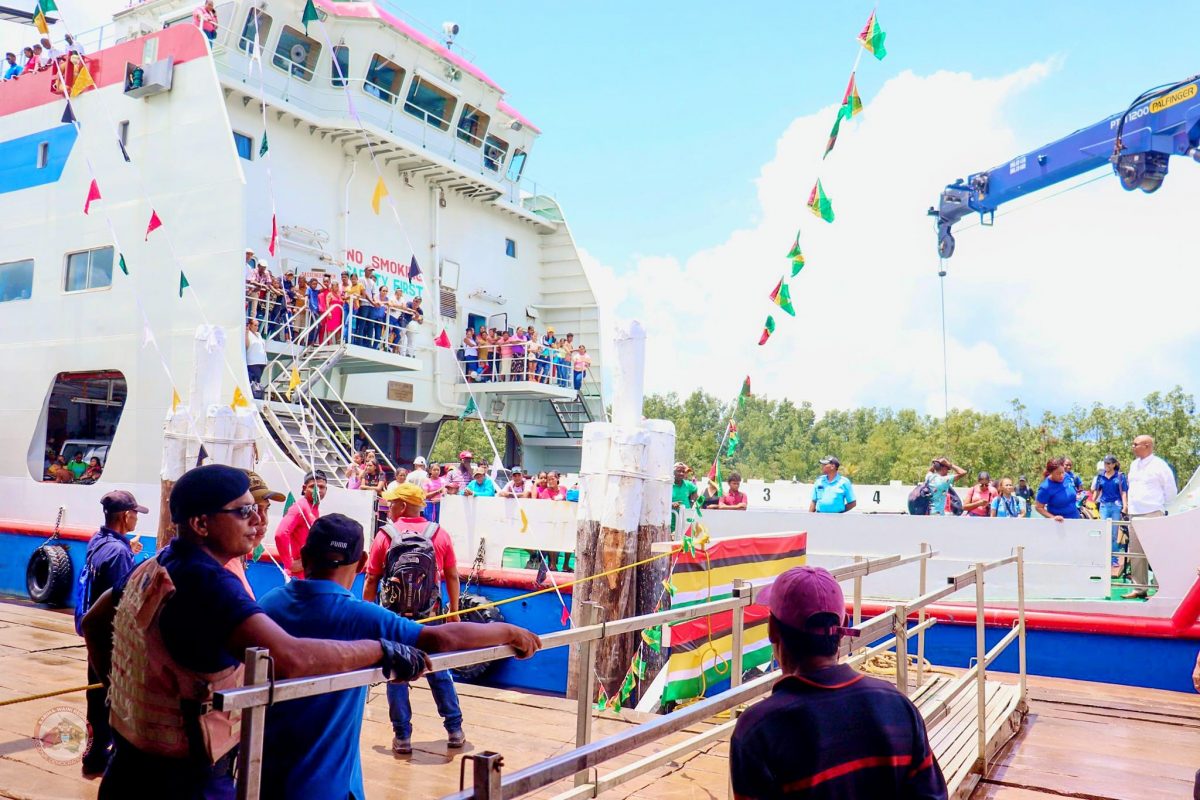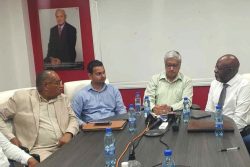The India-built, ocean-going ferry MV Ma Lisha, yesterday docked at the KMC Bond, Kumaka, Region One as it completed its maiden voyage far quicker than its predecessor.
The journey which was set to take 12-15 hours actually took about 18 hours after the vessel set sail from Kingston, Georgetown on Thursday. Minister of Public Works, Juan Edghill who was a passenger on the vessel’s maiden voyage said “This is a fulfillment of a commitment that was made to the people of Region One. We could have sailed way before but we had to wait to get some civil works done to facilitate the mooring. This was successfully executed.”
Edghill said that most of those who were travelling had done so for the first time to Region One, as they figured it was a big boat and more comfortable. The MV Ma Lisha is worth some $2.5 billion and was constructed in India after a contract was signed between the Trans-port and Harbours Department (T&HD), Guyana, and Indian company, Gar-den Reach Shipbuilders and Engineers Limited (GRSE) back in January 2021. The government was able to fund the acquisition of the vessel via a loan/ grant it obtained from the Indian government.
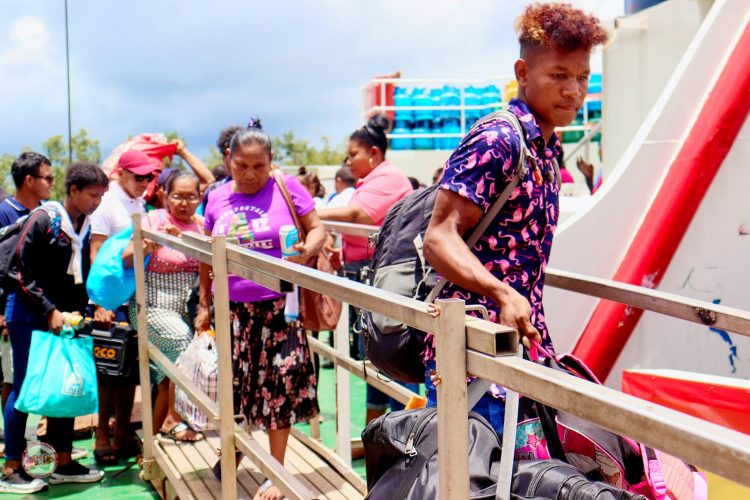
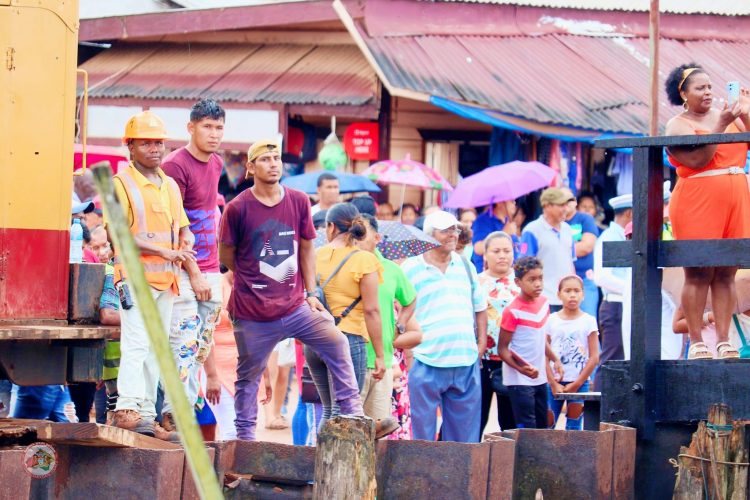
Back in April, the vessel arrived in Port George-town, after it sailed from Kolkata to Chennai and then made its way across the Atlantic to Trinidad. The vessel is 70 meters long and propelled by two diesel engines which can attain a top speed of 15 knots. It is said to be the largest and fastest ferry to operate in the riverain and coastal waters of Guyana. The vessel weighs 1,700 tonnes, can carry 294 passengers (including a 14-member crew), 14 cars, two trucks, and 14 containers, and also large quantities of produce.
The MV Ma Lisha can also carry 14 sedan-type vehicles along with two trucks and it also comprises a front loading/offloading ramp that accommodates easy loading and discharging of cargo at ports. The vessel also has side boarding capacity. A total of 19 navigational, mechanical, and auxiliary staff of the Transport and Harbours Department were trained in India in 2022 and earlier this year, to operate the new ferry vessel.
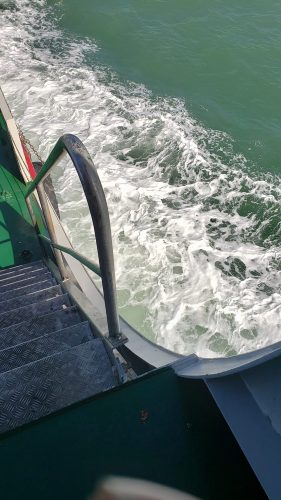
Edghill said that Government will be looking towards improving, not just the travel experience alone, but the ports, both in Georgetown and in Region One. “The people of Mabaruma might be pleased to know that we have already signed a contract for the consultancy services for the supervision of (the building of) a new stelling. So, if you notice the front of the boat there is something they just dropped. The vehicles will be able to drive up and off and we are building a stelling to facilitate that right here at Independence Road. At Port Kaituma, MV Malisha’s arrival is well in advance and we also have works happening at the Kingston stelling, where the passengers boarded.”
Additionally, Edghill noted that the confusion of waiting to purchase tickets or to acquire a seat on the vessel will also be a thing of the past with the new online booking process. “The real message we want to get over is the culture of lining up 4 O’ clock in the morning and trying to get a space in the line, we want to change that. There is now online booking. So, you could book online and pay for that and everything and you arrive two hours before departure and you could get on board, you can get your cargo on the boat because everything is done upfront”, he said.
One passenger, Andrew Campbell, a constant traveller to the region shared his experience of the boat and journey. He noted that in addition to the one hour late departure, the speed of the boat ensured that they were never going to make the time set. Campbell added that both the economy class and premium looked really good. However, the seating is not suitable for such a long journey. While it’s much more comfortable than the MV Kimbia, one cannot sleep on the chairs as they are upright. He said people still reverted to sleeping on the floor and between the chairs, while some sought areas where they could get to rest comfortably, and around 4 am he went to sleep in a tractor-trailer using some buckets and a suitcase as a cushion for his upper back.
Campbell said that the washroom facility was clean and well-kept and it was the first time he actually used the washroom when traveling on a Region One ferry, which for him was a big plus including showering if needed. He pointed out that the seating area was cool, however, the air conditioning unit needs to be adjusted a bit to make it much cooler, as some persons still said it was a bit hot. Additionally, he said that the boat did not rock as much, as he barely felt anything. But the real test, he said, will be next month and in December when the ocean gets rougher, with larger waves.
“The fact that the boat can carry tons of goods, whether perishable or non-perishable is a big plus for the Region. Hopefully, it will result in the cost of goods being much cheaper. It also means that farmers can ship out larger quantities of agricultural produce to Georgetown and possibly will result in the reduction in the price for spices,” Campbell added. Even with the positives, Campbell said they were some negatives with the canteen/kitchen being very small with a narrow entrance and next to one of the urinals in a hot area. He insisted that there is also a need to look at the railings on the steps as someone can easily slip and fall into the ocean; there are no spots available to tie hammocks, he also mentioned. All in all, he said that the journey was a better experience than previous travels.
